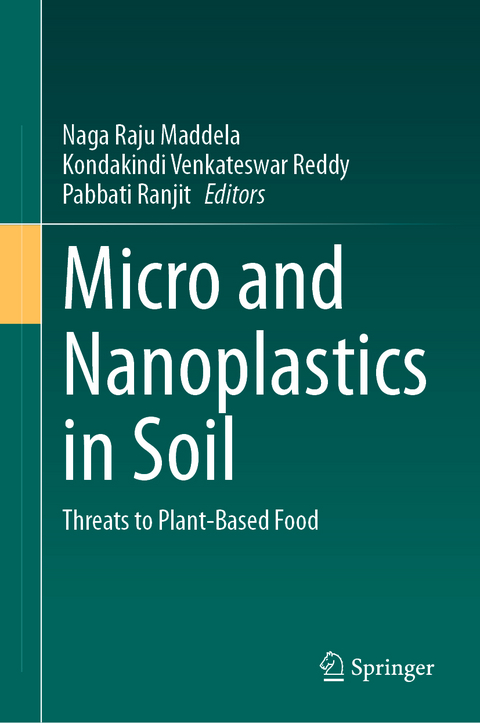
Micro and Nanoplastics in Soil
Springer International Publishing (Verlag)
978-3-031-21194-2 (ISBN)
This contributed volume gives a state-of-the-art overview of microplastics and nanoplastics (MPs and NPs) in soils and their relationship with growing plants. Through chapters contributed by a wide variety of researchers, the book offers readers an understanding of MP and NP adsorption, uptake, and effects, as well as implications for trophic transmission, food safety, and security. Cutting-edge topics such as trophic transfer and remediation of MPs and NPs in soil samples are also addressed.
The book begins with a primer on terrestrial MPs and NPs, their effects on terrestrial plants, and how these contaminants affect human populations. From there, the volume is split into four sections which address both problems caused by MPs and NPs in soil and potential remediation solutions. The first section deals with the mechanics of how MPs and NPs pollute soils and how toxic chemicals affect the soil profile and its flora, fauna and microbes. The second section of the book discusses trophic transfer of MPs and NPs from roots to shoot, shoot to leaves, and then to fruits. The third section details the threats to humans that are present as a result of MPs and NPs in soils. The fourth and last section gives covers bioremediation techniques that can be employed in order to reclaim polluted soils.
Naga Raju Maddela received his M.Sc. (1996–1998) and Ph.D. (2012) in Microbiology from Sri Krishnadevaraya University, Anantapuramu, India. During his doctoral program in the area of Environmental Microbiology, he investigated the effects of industrial effluents/insecticides on soil microorganisms and their biological activities and has been working as a Faculty in Microbiology since 1998, teaching undergraduate and postgraduate students. He received “Prometeo Investigator Fellowship” (2013–2015) from Secretaría de Educación Superior, Ciencia, Tecnología e Innovación (SENESCYT), Ecuador, and “Postdoctoral Fellowship” (2016–2018) from Sun Yat-sen University, China. He also received external funding from “China Postdoctoral Science Foundation” in 2017, internal funding from “Universidad Técnica de Manabí” in 2020, worked in the area of Environmental Biotechnology, participated in 20 national / international conferences, and presented research data in China, Cuba, Ecuador, India and Singapore. Currently, he is working as a full-time Professor at the Facultad de Ciencias de la Salud, Universidad Técnica de Manabí, Portoviejo, Ecuador. To his credit, there are 10 Books, 35 Chapters and 55 research papers. Kondakindi Venkateswar Reddy received his M.Sc (Microbiology) 2006-2008 from Srikrishnadevyaraya University, Anantapur, Andhrapradesh, M.Tech (Environmental Management) and Ph.D (2017) in Environmental Science and Technology from Jawaharlal Nehru Technological University Hyderabad, Kukatpally, Hyderabad, Telangana. During his doctoral program in the area of industrial microbiology, he worked on isolation, characterization and molecular identification of Cellulase Producing bacterial isolates used in aquaculture waste water treatment. He has been working as a faculty in Microbiology and Biotechnology for past13 years, teaching undergraduate and post graduate students. His forte is Industrial microbiology, Biotechnology and Environmental management. He has successfully completed four AICTE approved Faculty development programmes in the areas of Applied Environmental microbiology, Experimental Biotechnology. Biochemistry and Cell biology. He has published 9 book chapters (Springer/ Taylor and Francis) and 30 research papers in reputed journals. He has actively participated in 20 National/ International conferences and presented various research papers in prestigious Universities. Currently, he is working as an Asst. Professor at Center for Biotechnology, Institute of Science and Technology Jawaharlal Nehru Technological University Hyderabad, Kukatpally, Hyderabad. Pabbati Ranjit completed B. Tech (2003-2007), M. Tech (2007-2009) and Ph.D. in Biotechnology from Jawaharlal Nehru Technological University, Hyderabad, India. His research work focused on area of medicinal plant biotechnology for evaluation of its antimicrobial activity on various pathogenic bacteria, and antioxidant activity. He also worked to understand the secondary metabolite biosynthesis pathways for mapping of genes involved in antimicrobial activity by transcriptome analysis using next generation sequencing technique. He has 10 years of teaching experience, teaching undergraduate and post graduate students. He has mentored undergraduate and postgraduate students for their projects. He has received internal grant form Technical Education Quality Improvement Programme of Government of India (TEQIP), worked in the area of Plant biotechnology. Currently he is working as a Assistant professor at Centre for biotechnology, Institute of Science and Technology, Jawaharlal Nehru Technological University, Hyderabad, India. He published Nine book chapters (springer and Taylor & Francis) and twenty research papers according to the research findings.
Part1. Soil Pollution by Micro and Nanoplastics.- Chapter1. Soil Pollution by Micro and Nanoplastics: An overview.- Chapter2. Soil Pollution by Micro and Nanoplastics: Sources, Fate and Impact.- Chapter3. Abundance and Distribution of MPs and NPs in Soil - A Global Scenario.- Chapter4. Methodology of assessing micro plastics and nano plastics in the environment -Recent advances in the practical approaches.- Chapter5. Persistence of Micro and Nanoplastics in Soil.- Chapter6. Microplastics as a carrier of antibiotic resistance genes - a revision of literatureiz.- Part2. Trophic transfer of Micro and Nanoplastics.- Chapter7. Phytoaccumulation of Micro and Nanoplastics: Root Uptake.- Part3. Toxicity of Micro and Nanoplastics.- Chapter8. Toxicity Effects of Micro and Nanoplastics in Terrestrial Environment.- Chapter9. Ecological Impacts and Toxicity of Micro and Nanoplastics in Agroecosystem.- Chapter10. Micro and Nanoplasticson Plant Functionalities.- Chapter11. Cellular and Animal Toxicities of Micro and Nanoplastics.- Part4. Bioremediation of Micro and Nano plastics- polluted soil.- Chapter12. Restoration of Micro/Nanoplastics-contaminated Soil by Phytoremediation.- Chapter13. Bacterial Remediation of Micro/Nanoplastics-contaminated soil.- Chapter14. Mycoremediation of Micro and Nano Plastics (MNPs) - contaminated Soils.- Chapter15. Emerging Techniques for the Mitigation of Micro and Nanoplastics in Soil.- Chapter16. Micro and Nanoplastics in Agricultural Soils: Challenges and Future directions.
| Erscheinungsdatum | 08.03.2023 |
|---|---|
| Zusatzinfo | XX, 431 p. 58 illus., 42 illus. in color. |
| Verlagsort | Cham |
| Sprache | englisch |
| Maße | 155 x 235 mm |
| Gewicht | 835 g |
| Themenwelt | Sachbuch/Ratgeber ► Natur / Technik ► Natur / Ökologie |
| Naturwissenschaften ► Biologie ► Botanik | |
| Naturwissenschaften ► Biologie ► Ökologie / Naturschutz | |
| Naturwissenschaften ► Geowissenschaften | |
| Weitere Fachgebiete ► Land- / Forstwirtschaft / Fischerei | |
| Schlagworte | Adsorption • Microplastic pollution • Microplastic remediation • Microplastics • Microplastics in plants • Nanoplastics • Soil Remediation • Tropic transfer |
| ISBN-10 | 3-031-21194-4 / 3031211944 |
| ISBN-13 | 978-3-031-21194-2 / 9783031211942 |
| Zustand | Neuware |
| Informationen gemäß Produktsicherheitsverordnung (GPSR) | |
| Haben Sie eine Frage zum Produkt? |
aus dem Bereich


